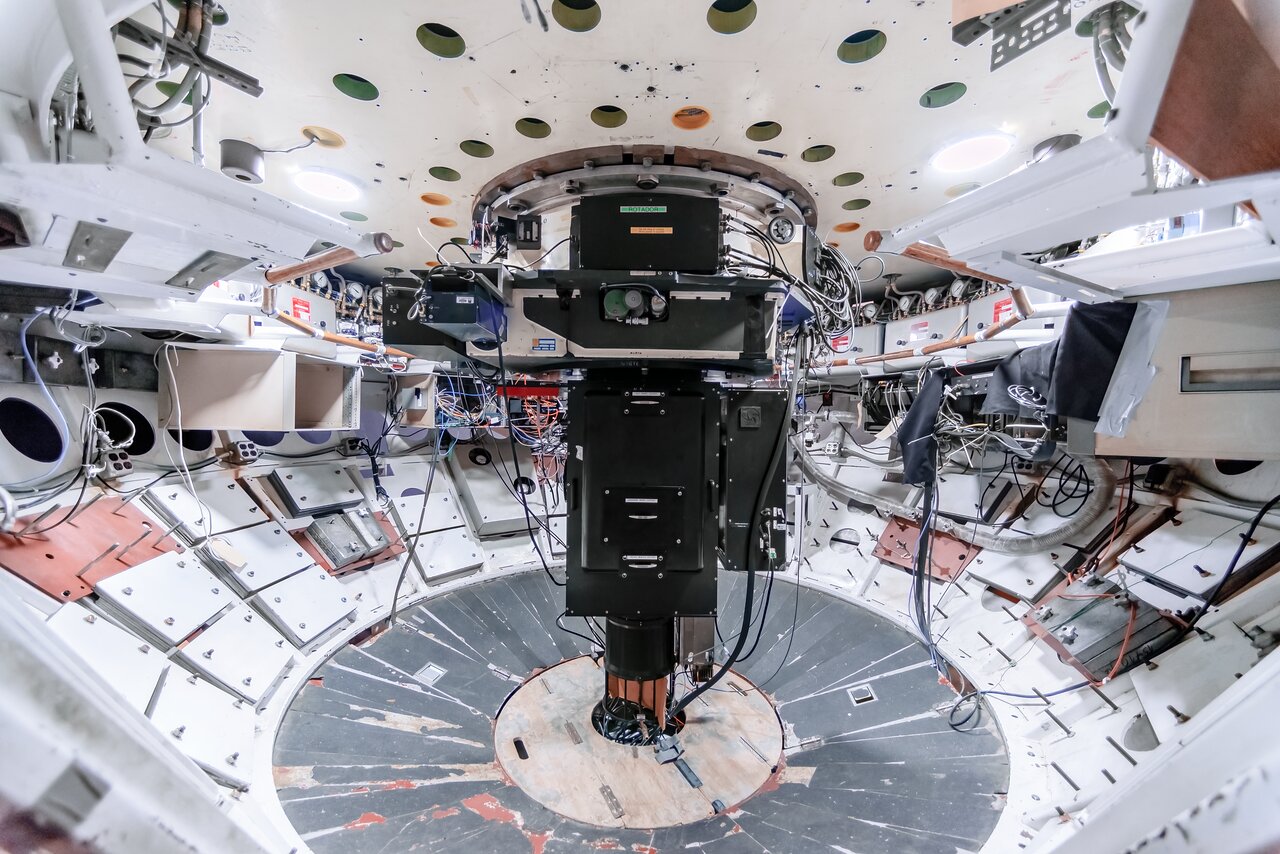Cerro Tololo Ohio State Multi-Object Spectrograph (COSMOS)
COSMOS is shown mounted in the Cassegrain Cage of the Víctor M. Blanco 4-meter Telescope.
COSMOS is the Cerro Tololo Ohio State Multi-Object Spectrograph, a visible-light spectrograph and imager at the Víctor M. Blanco 4-meter Telescope at Cerro Tololo Inter-American Observatory, a Program of NSF's NOIRLab. This instrument was built to provide a modern, high-efficiency spectrograph for the science community that meets many of the scientific needs described in the ReSTAR (Renewing Small Telescopes for Astronomical Research) Report. COSMOS was commissioned in April 2014.
COSMOS, based on OSMOS (Ohio State Multi-Object Spectrograph), includes an all-refractive optical design that enables imaging, long-slit and multi-slit spectroscopy over a wide field. COSMOS can have a wide range of slit masks, filters and dispersers mounted simultaneously and allows for rapid reconfiguration between observing modes. COSMOS has an approximately 10-arcminute circular field of view, at a scale of 0.29 arcseconds per pixel. This same field is available for spectroscopy with multi-object slit masks. COSMOS was commissioned with two Volume Phase Holographic (VPH) grisms, named the B2K and R2K grisms. Each provides a resolving power of approximately R ~ 2000 with a 0.9-arcsecond- wide slit. The nominal wavelength ranges are 380 nm to 660 nm for the B2K grism and 580 nm to 940 nm for the R2K grism, although somewhat shifted wavelength coverage is possible with offset slits. Since commissioning, we have acquired three additional VPH grisms, the L2K, the B4K, and the V4K grisms. The L2K grism covers the wavelength range between 360 nm and 740 nm with a resolving power of R ~ 2000. The B4K (V4K) grism covers the wavelength range of 400 nm to 570 nm (510 nm to 720 nm) with a resolving power of R ~ 4000 with the 0.9-arcsecond-wide slit. As with the B2K and R2K grisms, the wavelength ranges of these new grisms can be shifted using offset slits.
Science Highlights of COSMOS
Quick Facts
|
Cerro Tololo Ohio State Multi-Object Spectrograph (COSMOS)The technical information for astronomical observations is available at the NOIRLab Science webpage |
|
|
Site |
Cerro Tololo |
|
Telescope |
Víctor M. Blanco 4-meter Telescope |
|
Type |
Imager / Spectrograph / Multi-Object Spectrograph (MOS) |
|
Wavelength range |
320–980 nm |
|
Spatial resolution: |
0.292” per pixel |
|
Detector Number |
1 |
|
Detectors size |
2K x 4K |
|
Spectral resolution: |
R = 1800–4000 Slit width options: 0.6”, 09”, 1.2”, 1.5” and 3.0”. |
|
Field of view |
10′ / Slit 0.6”, 0.9”, 1.2”, 1.5,” 3.0” / 5′ x 10′ MOS |
|
Filters |
u, U, C ,B ,M, g, DDO 51, V, Y, T1, R ,r, H-alpha ,SII ,I, i, Z, z |
|
First Light Date |
April 2014 |
|
Science Goals |
Measurement of stellar radial velocities and galaxy redshifts, object classification, confirmation of photometrically identified candidates, and determination of physical properties such as temperature and metallicity all depend on obtaining optical spectra. Stellar spectral classification for measurements of the initial mass function. The confirmation and characterization of brown dwarfs. Spectroscopy for confirmation and characterization of novae. Spectroscopy of active galactic nuclei. Galaxy rotation curves. Studies of extragalactic globular cluster systems. Measurement of the Ca triplet in giant stars in Local Group galaxies. Radial velocity curves in eclipsing binary systems. Stellar kinematics. Spectroscopy of extragalactic supernovae. |
|
Images taken with the instruments |
Link |
|
Images of the instrument |
Link |
|
Videos of the Instrument |
Link |
|
Press releases with the instrument |
Link |
